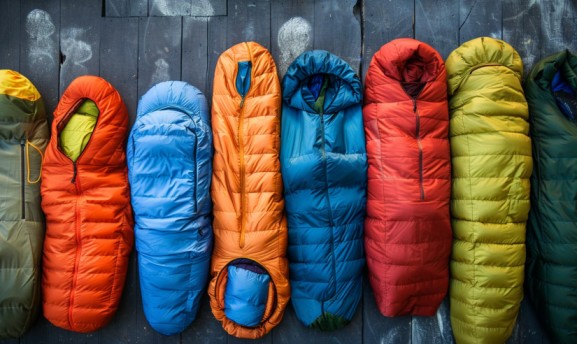
Imagine this: you’ve just returned from an incredible camping trip under the starry night sky, feeling rejuvenated and at one with nature. As you unpack your gear, you carefully fold your trusty sleeping bag, grateful for its warmth and comfort throughout the adventure. But what happens next? How you store your sleeping bag plays a crucial role in its longevity and performance for future trips.
Whether you’re a seasoned backpacker or a weekend warrior, knowing how to store your sleeping bag properly is essential. By following a few simple tips and tricks, you can preserve the quality of your sleeping bag, ensuring many more nights of restful sleep in the great outdoors.
Step-By-Step Guide: How to Store A Sleeping Bag
Properly storing your sleeping bag is essential for maximizing its lifespan and ensuring it’s ready for your next adventure. Follow these step-by-step instructions to store your sleeping bag effectively:
- Clean your sleeping bag: Before storing your sleeping bag, make sure it’s clean. Follow the manufacturer’s instructions for cleaning and drying your sleeping bag. If you’re unsure, check out our previous section on how to clean a sleeping bag for detailed guidelines.
- Air out your sleeping bag: It’s crucial to properly air out your sleeping bag before storing it. Find a well-ventilated area, preferably outdoors, and gently shake your sleeping bag to remove any debris and help it regain its loft. You can even use a clothesline to hang it in a breezy spot for a few hours.
- Loosely roll or fold it: When it comes to folding or rolling your sleeping bag, the key is to avoid compressing the insulation excessively. Start by folding it in half lengthwise, then roll it up loosely from the bottom. This method helps prevent permanent creases and ensures the insulation retains its loft.
- Store in a breathable sack: It’s essential to store your sleeping bag in a breathable sack, preferably a large cotton or mesh bag, to allow air circulation. Avoid using a compression sack for long-term storage as it can damage the insulation fibers.
- Find the ideal storage location: Pick a dry, cool location to store your sleeping bag. Avoid areas prone to temperature fluctuations, direct sunlight, and excessive moisture. Options include a clean closet, under your bed, or on a high shelf in a spare room.
By following this step-by-step guide, you’ll ensure that your sleeping bag remains in excellent condition, ready for your next camping or hiking trip.
Now that you know how to store your sleeping bag properly, let’s explore the best locations to store sleeping bags in the next section.
Where To Store Sleeping Bags
To preserve the quality of your sleeping bag, it is important to store it in the right location. The ideal place for sleeping bag storage is a cool, dry environment away from direct sunlight. This helps prevent damage and ensures that your sleeping bag remains in optimal condition for future adventures.
A cool and dry room or cupboard is the best choice for storing your sleeping bag. This location allows the bag to fully loft and air out, keeping it fresh and ready for use. Avoid storing your sleeping bag in areas that are prone to temperature fluctuations or dampness, such as attics, basements, garages, or sheds. These environments can lead to mold, mildew, and degradation of the insulation.
Remember, proper sleeping bag storage is essential for maintaining its insulation properties and extending its lifespan. By storing your sleeping bag in a cool and dry place, you ensure that it is always in the best condition for your next outdoor adventure.
Keep in mind:
- Store your sleeping bag in a cool, dry room or cupboard.
- Avoid direct sunlight and areas with temperature fluctuations.
- Avoid storing in damp environments like attics, basements, garages, or sheds.
Sleeping Bag Care and Maintenance Tips
Proper care and maintenance of your sleeping bag are essential for its longevity. Follow these tips to ensure your sleeping bag stays in top condition:
- Spot clean any stains or dirt marks immediately after each trip. Use a gentle detergent and a soft brush or sponge to target the affected areas. Rinse thoroughly and allow the bag to air dry completely.
- Use a sleeping bag liner to protect the interior from dirt and oils. Liners act as a barrier, preventing these substances from seeping into the down or synthetic insulation, preserving its loft and warmth.
- Air out your sleeping bag frequently to prevent odors. When you return from a trip, hang your bag in a well-ventilated area and allow it to breathe for a few hours before packing it away.
- Avoid sleeping in a dirty bag. Clean yourself up before getting into the bag to minimize the transfer of dirt, oils, and sweat. This helps maintain the cleanliness of your sleeping bag and prolong its freshness.
- Use a ground sheet and sleeping pad when camping without a tent to protect the bag from direct contact with the ground. This prevents abrasion and keeps moisture from seeping into the bag.
Properly maintaining your sleeping bag will ensure it remains in excellent condition for years to come.
Conclusion
Properly storing a sleeping bag is essential for maintaining its quality and ensuring a longer lifespan. By following the step-by-step guide provided in this article, choosing the right storage location, and implementing proper care and maintenance practices, you can keep your sleeping bag in excellent condition for years of comfortable camping.
Remember to clean your sleeping bag regularly and spot clean any stains or dirt marks immediately after each trip. Make sure to air out your sleeping bag frequently to prevent odors and avoid storing it in a compressed state. Instead, store it in a cool and dry place, away from direct sunlight, and use a sleeping bag liner to protect the interior from dirt and oils.
By implementing these simple tips and tricks, you’ll be able to enjoy many restful nights of sleep in your well-preserved sleeping bag. So, take care of your sleeping bag, and it will take care of you on your upcoming camping adventures!


